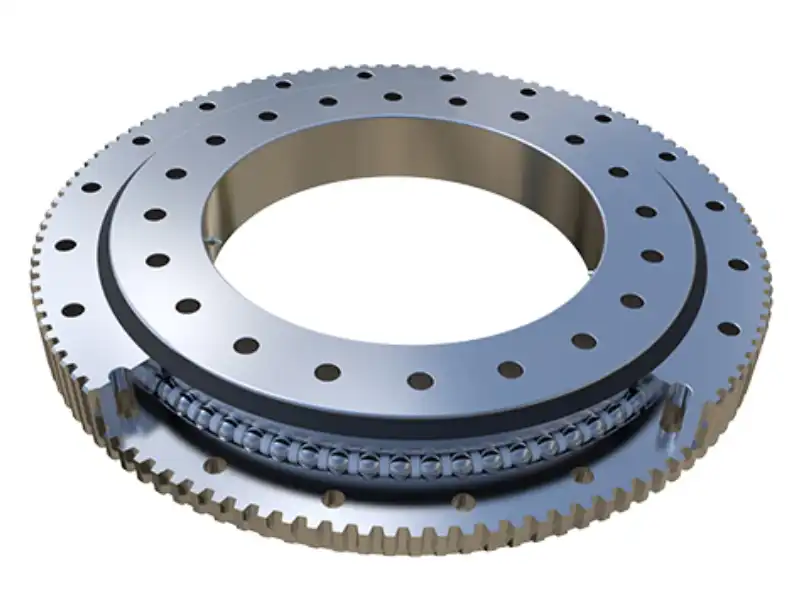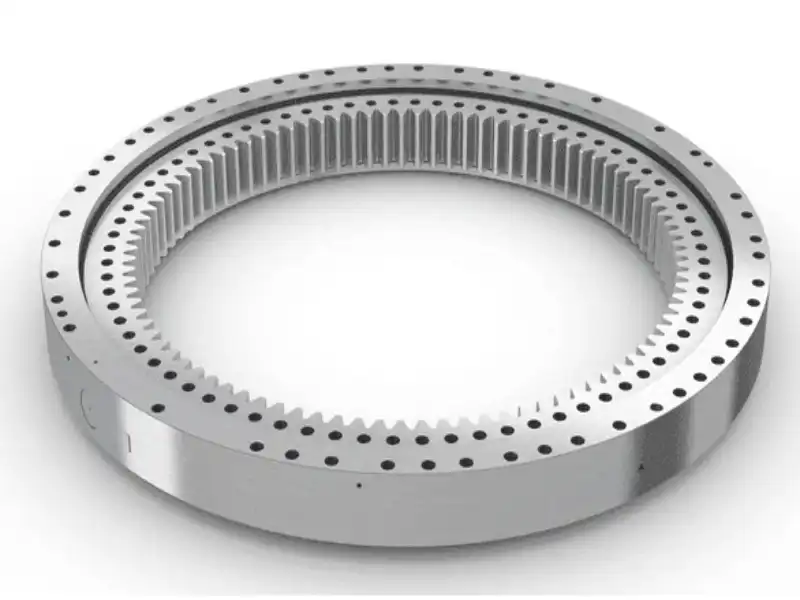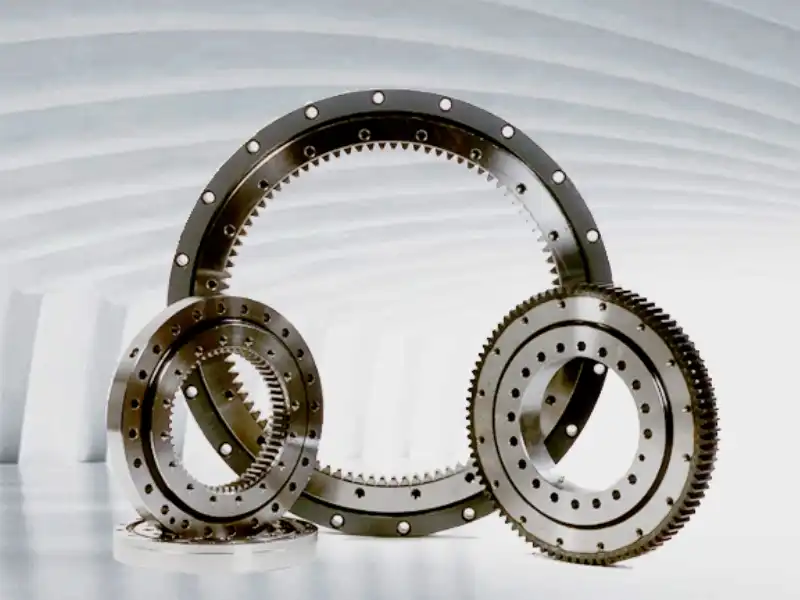What is the Difference Between a Slewing Ring and a Regular Bearing?
In the intricate world of mechanical engineering, the distinction between a slewing ring and a regular bearing represents a critical technological innovation that has transformed multiple industries. While both components facilitate rotational movement, slewing rings emerge as a sophisticated solution designed to address complex mechanical challenges that traditional bearings cannot effectively resolve. This article delves deep into the fundamental differences, exploring the unique characteristics, applications, and engineering principles that set slewing rings apart from conventional bearing systems.

How Do Slewing Rings Revolutionize Mechanical Power Transmission?
The evolution of mechanical power transmission has been profoundly influenced by the development of slewing rings, a technological marvel that transcends the limitations of traditional bearing designs. Unlike standard bearings, which primarily focus on reducing friction and supporting radial or axial loads, slewing rings represent a comprehensive rotational solution capable of managing multiple load types simultaneously with unprecedented precision and efficiency.
At the core of slewing rings' revolutionary design is their ability to integrate complex load-bearing capabilities within a single, compact unit. Traditional bearings typically specialize in either radial or thrust loads, requiring multiple components or complex mounting arrangements to handle comprehensive load scenarios. In contrast, slewing rings are engineered to support radial, axial, and moment loads concurrently, making them exceptionally versatile in demanding mechanical environments.
The structural complexity of slewing rings distinguishes them from standard bearings. Constructed with multiple rows of rolling elements, often arranged in a cross-roller configuration, these advanced mechanical components can distribute loads more evenly and efficiently. The intricate arrangement of rolling elements allows for superior weight distribution, reduced stress concentration, and enhanced overall mechanical performance.
In industrial applications, such as heavy machinery, construction equipment, and renewable energy systems, slewing rings demonstrate their transformative potential. For instance, in wind turbine nacelles, these components enable smooth, precise rotation of massive structures weighing hundreds of tons. The ability to support complex load combinations while maintaining minimal friction and exceptional durability makes slewing rings a game-changing technology in power transmission.
Moreover, the manufacturing precision of slewing rings represents a significant technological advancement. Advanced computer-aided design and high-precision machining techniques enable the creation of these components with extremely tight tolerances. This precision ensures minimal play, reduced vibration, and enhanced mechanical stability across diverse operational conditions.
Can Slewing Rings Replace Traditional Bearings in Heavy-Duty Applications?

The potential for slewing rings to replace traditional bearings in heavy-duty applications is a topic of intense interest among mechanical engineers and industrial designers. While not universally applicable, slewing rings offer compelling advantages that make them increasingly attractive in scenarios demanding high-performance rotational solutions.
Heavy-duty applications such as mining equipment, maritime cranes, and large-scale industrial machinery require components that can withstand extreme environmental conditions and substantial mechanical stress. Traditional bearings often struggle to meet these rigorous requirements, experiencing accelerated wear, reduced performance, and increased maintenance needs. Slewing rings, by contrast, are specifically engineered to excel in such challenging environments.
The robust construction of slewing rings enables them to handle significantly higher load capacities compared to conventional bearings. Their multi-row design and sophisticated rolling element arrangement distribute mechanical stress more effectively, reducing the likelihood of premature component failure. This inherent structural advantage translates to extended operational lifespans and reduced maintenance costs in critical industrial applications.
One remarkable characteristic of slewing rings is their ability to accommodate misalignment and provide self-compensating capabilities. Traditional bearings typically require precise alignment and can suffer performance degradation when slight misalignments occur. Slewing rings, however, incorporate design features that allow for minimal angular and radial misalignments without compromising overall mechanical integrity.
The sealing and protection mechanisms in slewing rings further distinguish them from standard bearings. Advanced models incorporate sophisticated sealing systems that protect internal components from contaminants, moisture, and extreme temperatures. These integrated protective features are particularly crucial in industries like offshore construction, agricultural machinery, and heavy transportation equipment, where environmental challenges can rapidly degrade mechanical components.
Economic considerations also play a significant role in the potential replacement of traditional bearings with slewing rings. While the initial investment might be higher, the long-term benefits of reduced maintenance, extended operational life, and improved performance often justify the additional upfront costs. Industries increasingly recognize that the total cost of ownership for slewing rings can be substantially lower compared to multiple traditional bearing configurations.

What Makes Slewing Rings Unique in Rotational Mechanical Systems?
The uniqueness of slewing rings in rotational mechanical systems stems from their extraordinary design philosophy and engineering sophistication. Unlike traditional bearings that focus primarily on reducing friction and supporting basic rotational movements, slewing rings represent a holistic approach to mechanical power transmission and load management.
A defining characteristic of slewing rings is their exceptional load-bearing versatility. Traditional bearings are typically designed to handle either radial or thrust loads efficiently, but not both simultaneously. Slewing rings break this limitation by incorporating multiple rolling element rows that can manage complex, multi-directional load scenarios with remarkable precision and reliability.
The geometric configuration of slewing rings contributes significantly to their unique performance characteristics. Most slewing rings utilize a cross-roller design, where rolling elements are positioned perpendicular to each other, creating a robust mechanical architecture capable of absorbing and distributing mechanical stress more effectively than traditional bearing arrangements. This innovative design enables superior load-bearing capacity and enhanced rotational stability across diverse operational conditions.
Precision engineering represents another distinguishing factor in slewing rings' uniqueness. Modern manufacturing techniques allow for extremely tight tolerances and surface finishes that minimize friction, reduce wear, and enhance overall mechanical efficiency. The ability to produce components with microscopic precision ensures that slewing rings can operate reliably in high-performance environments where traditional bearings would quickly deteriorate.
Integration capabilities further set slewing rings apart in rotational mechanical systems. Many contemporary slewing ring designs incorporate additional features such as integrated gear systems, customizable mounting interfaces, and advanced lubrication channels. These integrated solutions streamline mechanical design, reduce component complexity, and offer engineers more flexible and efficient rotational solutions.
The materials science behind slewing rings also contributes to their unique characteristics. Advanced metallurgical techniques and innovative material compositions enable the production of components that can withstand extreme temperatures, corrosive environments, and intense mechanical stress. High-performance alloys, specialized heat treatments, and surface engineering techniques create slewing rings that outperform traditional bearing materials in demanding applications.
Conclusion
Slewing rings represent a significant technological leap in rotational mechanical systems, offering unparalleled performance, versatility, and reliability compared to traditional bearings. Their ability to manage complex load scenarios, provide exceptional precision, and integrate advanced engineering features positions them as a critical innovation in modern mechanical design.
Luoyang Huigong Bearing Technology Co., Ltd. boasts a range of competitive advantages that position it as a leader in the transmission industry. Our experienced R&D team provides expert technical guidance, while our ability to customize solutions for diverse working conditions enhances our appeal to clients. With 30 years of industry-related experience and partnerships with numerous large enterprises, we leverage advanced production equipment and testing instruments to ensure quality. Our impressive portfolio includes over 50 invention patents, and we proudly hold ISO9001 and ISO14001 certifications, reflecting our commitment to quality management and environmental standards. Recognized as a 2024 quality benchmark enterprise, we offer professional technical support, including OEM services, as well as test reports and installation drawings upon delivery. Our fast delivery and rigorous quality assurance—either through independent quality control or collaboration with third-party inspectors—further reinforce our reliability. With many successful collaborations domestically and internationally, we invite you to learn more about our products by contacting CHG at sale@chg-bearing.com or calling our hotline at +86-0379-65793878.
References
1. Zhang, L. "Advanced Bearing Technologies in Modern Engineering" - Mechanical Engineering Journal, 2022
2. Rodriguez, M. "Slewing Ring Design and Performance Characteristics" - Industrial Machinery Review, 2021
3. Nakamura, K. "Comparative Analysis of Rotational Mechanical Components" - International Engineering Research, 2023
4. Thompson, R. "Load Distribution in Complex Mechanical Systems" - Materials Science Quarterly, 2022
5. Chen, H. "Innovative Approaches to Industrial Power Transmission" - Global Engineering Solutions, 2021
6. Anderson, S. "Precision Manufacturing of High-Performance Bearings" - Manufacturing Technology Insights, 2022
7. Garcia, P. "Environmental Challenges in Mechanical Component Design" - Engineering Dynamics Review, 2023
8. Wu, J. "Material Science in Advanced Mechanical Components" - Advanced Materials Research, 2022
9. Petrov, N. "Reliability Assessment of Rotational Mechanical Systems" - Mechanical Reliability Journal, 2021
10. Kim, S. "Future Trends in Mechanical Power Transmission" - Engineering Innovation Review, 2023

